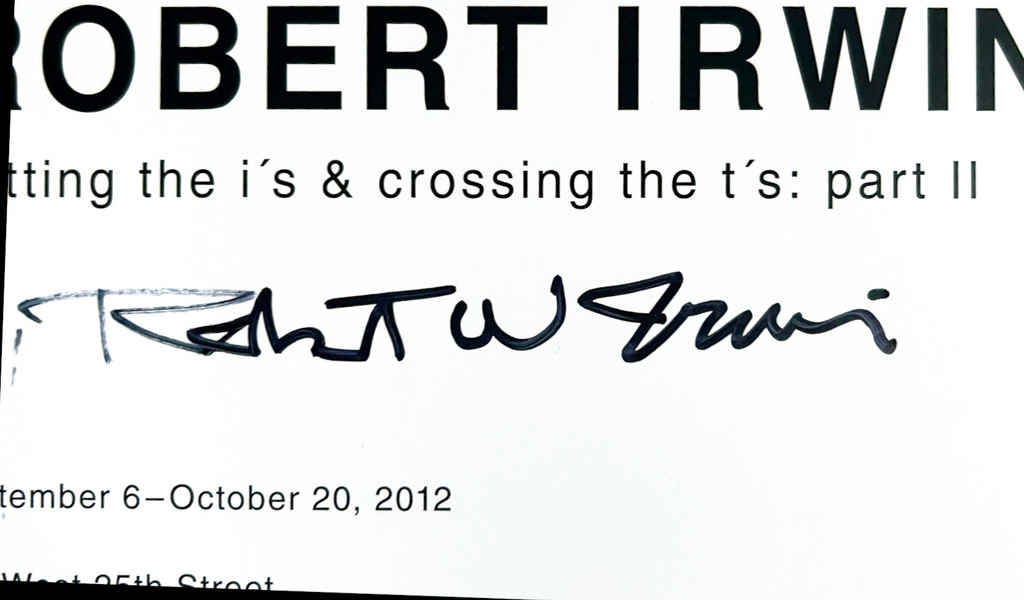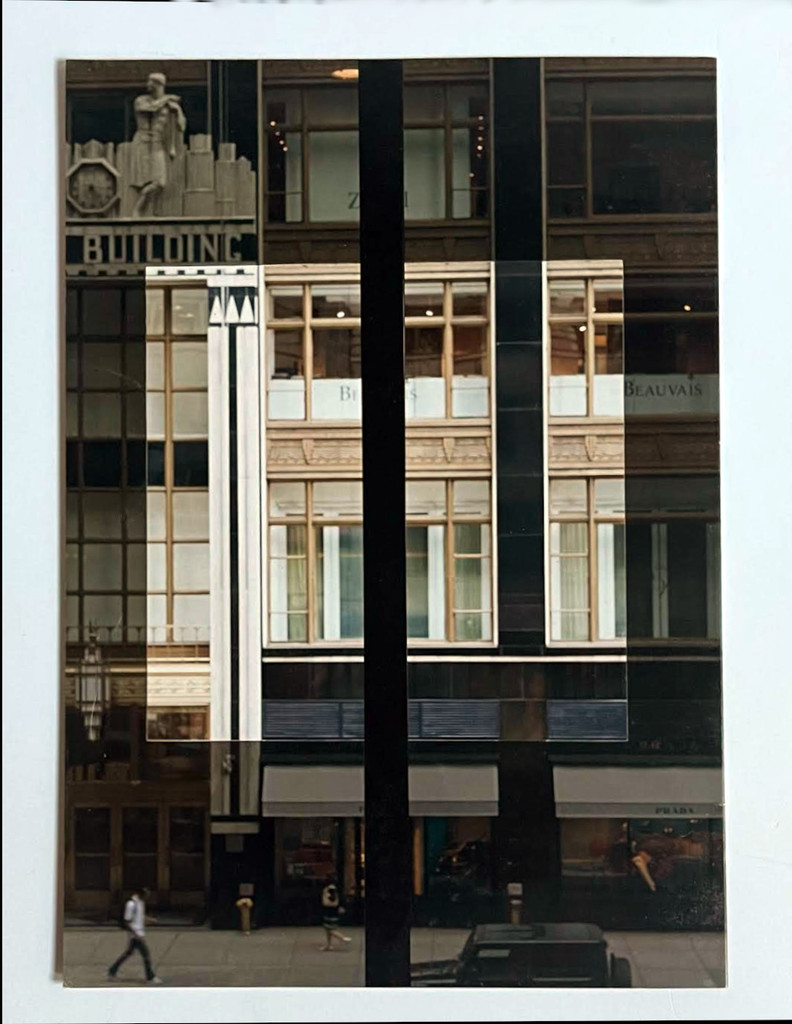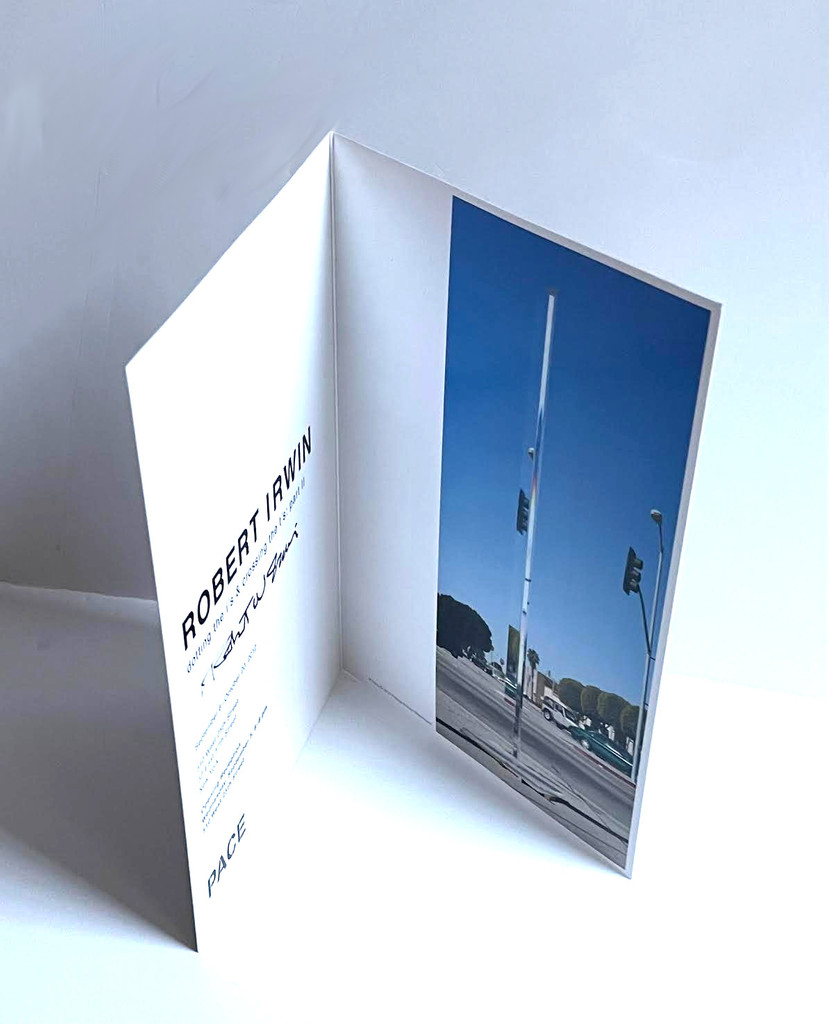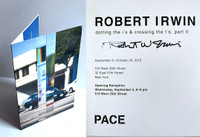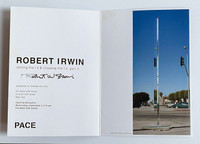
An Educated Collector is Our Best Client
In business for nearly two decades, we are a well established, popular contemporary art boutique specializing in expertly chosen, blue chip prints, multiples, uniques, books, ephemera and merchandise at different price points, with a focus on the secondary market. Please click on the "Contact Us" button at the bottom of this page for questions about any work, pricing and/or to arrange to visit our showroom/gallery - located in between Manhattan's Flatiron and Chelsea Flower Districts.
Robert Irwin, Fold-out PACE Gallery invitation (hand signed by Robert Irwin), 2012
CONTACT GALLERY FOR PRICE
Description
Robert Irwin
Fold-out PACE Gallery invitation (hand signed by Robert Irwin), 2012
Offset lithograph fold-out invitation (hand signed by Robert Irwin)
Boldly signed by Robert Irwin on the inside
10 × 7 inches
Unframed
This fold out invitation was published on the exhibition "Robert Irwin dotting the i's & crossing the t's: part II" at PACE Gallery in New York CIty from September 6 to October 20, 2012.
It was hand signed by Robert Irwin at PACE Gallery on September 5, 2012 for the present owner
About Robert Irwin:
Robert Irwin is among the most significant American artists and theoreticians working today and is renowned for his innovative site-conditioned artworks that explore the effects of light through interventions in space and architecture.
Developing an Abstract Expressionist approach to painting by the late 1950s, Irwin had his first monographic exhibition at Felix Landau Gallery, Los Angeles, in 1957, then moving to the newly founded Ferus Gallery, where he began exhibiting in 1958. By the early sixties, Irwin shifted to creating more restrained works with his line paintings, guided principally by questions of structure, color, and perception, and his dot paintings, works on gently bowed supports composed with small dots of near-complementary colors. In 1966, Irwin initiated a series of curved aluminum and acrylic discs that he painted and displayed with an arm extending out from the wall, creating a viewing experience that is impossible for a work on canvas.
By 1970, Irwin abandoned his studio, embarking on an extended inquiry of artmaking beyond the frame and the traditional art object. Working in existing sites, he composes with materials that are ephemeral, but which substantially transform the viewers’ visual and phenomenological experience. Irwin’s interventions blur the distinctions between space and artwork, exploring the nature of light, volume, and perceptual psychology.
Irwin has created numerous permanent installations for museums and other public sites such as 1° 2° 3° 4° (1997) at the Museum of Contemporary Art San Diego, La Jolla, his first permanent museum installation. Framing an ocean view and literally opening up the gallery space to exterior light, air, smells, and sounds, 1° 2° 3° 4° exemplifies the subtle but dramatic transformations inherent to Irwin’s work. For its 125th anniversary, Indianapolis Museum of Art commissioned Light and Space III (2008) for its Pulliam Great Hall, a multifloored interior space in which the artist arranged fluorescent lights to create an irregular grid, flanked by semi-transparent fabric scrims.
Irwin has also created permanent site-conditioned landscape works, a facet of his practice initiated by his design of the Central Gardens at the J. Paul Getty Center, Los Angeles (1997). The Central Garden incorporates Irwin’s landscape design in accord with Richard Meier’s architecture and the ravine of its site, as well as layered combinations of plantings that juxtapose color, texture, and other sensory experiences with natural forms that vary over time.
Irwin’s large-scale permanent installation Untitled (dawn to dusk) opened in July 2016 at the Chinati Foundation in Marfa, Texas, occupying the site of a dilapidated former hospital building measuring approximately 10,000 square feet. Irwin designed the courtyard and divided the building’s interior into two halves—making one wing dark and the other light. With regularly spaced windows and scrims bisecting each side, the installation orchestrates viewers’ perceptions of light, interior space, and the surrounding landscape. The project, which was in development for fifteen years, is the first free-standing structure devoted exclusively to Irwin’s work. Over the past decade, Irwin has returned to his studio, using it as an experimental space to develop sculptural works with florescent lights and acrylic, such as his Sculpture/Configuration works exhibited at Pace in New York (2018), while continuing to develop his site-conditioned installations.
Irwin employs a wide range of media, from fluorescent lights to fabric scrims, colored and tinted gels, paint, wire, acrylic, and glass. He makes art that he considers “conditional,” responding to the context of its specific environment while displacing emphasis away from the materials themselves, however, drawing our attention to perception.
Courtesy of PACE Gallery


